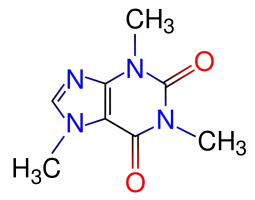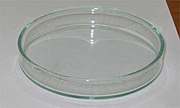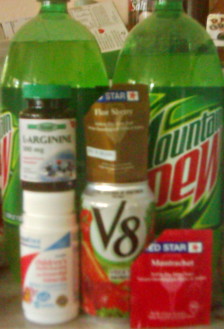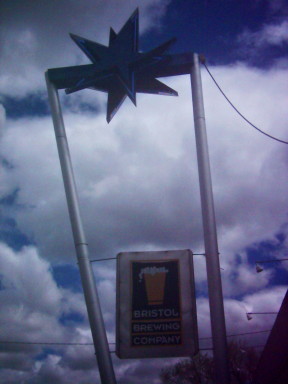<whine excuse=”obligatory”>Have I ever mentioned what a huge hassle it is to relocate from one abode to another 1600 miles away?…</whine>
 I’m finally back at House v1.0 where I can check on the progress of my Mountain Dew® Wine. It appears to have managed to ferment, in spite of the severe dose of preservatives in the stuff designed to prevent that from happening. It went somewhat slowly, but it’s gone from an original gravity of around 1.054 down to about 1.011 or so, suggesting about, say, 5-6% alcohol in the final product, which has faded to a pale, cloudy yellow color. Hopefully the cloudiness is from still-living yeast, which has now demonstrated that it is reasonably benzoic-acid-and-caffeine tolerant.
I’m finally back at House v1.0 where I can check on the progress of my Mountain Dew® Wine. It appears to have managed to ferment, in spite of the severe dose of preservatives in the stuff designed to prevent that from happening. It went somewhat slowly, but it’s gone from an original gravity of around 1.054 down to about 1.011 or so, suggesting about, say, 5-6% alcohol in the final product, which has faded to a pale, cloudy yellow color. Hopefully the cloudiness is from still-living yeast, which has now demonstrated that it is reasonably benzoic-acid-and-caffeine tolerant.
I fear I must report that the result is a crushing disappointment to me. It’s not very good. Worse yet, it’s not very bad, either. I was hoping that if it wasn’t surprisingly tasty that it would at least be shockingly awful in some interesting way so I’d have something entertaining to say about it here.
Actually, the adjective that comes to mind is “inoffensive”. If you would like to whip up a quick simulation of what I’ve got here, you might be able to do it like this: Take some citrus-flavored sparkling mineral water. Dilute it about half with (uncarbonated) distilled water. Then mix about 7 volumes of that with one volume of vodka. What I’ve got here is slightly sparkling, with a barely noticeable citrus flavor and little or no remaining sweetness. It’s a little surprising to me just how much of the flavor of Mountain Dew® apparently comes from its sweetness. Perhaps next time I try this (if there ever IS a “next time”…) I’ll have to mix regular and “diet” Mountain Dew® – with some bonus sugar to make up the difference, of course.
I’m not completely done here. I’m still going to dispense it into cleaned bottles with a little bit of sugar to prime it for full carbonation. Sanitized plastic soda-bottles of course – none of that snobby glass stuff for this here experimental drinkin’ substance! It may be high-class for “pruno”, but it’s sure as heck not Champagne™. (Besides, I want to evaluate reusing plastic bottles anyway – it’d be a lot easier to tell when there’s too much pressure and to let some of the pressure off if there is.) Plus, I need to take some of the still-live yeast and keep it alive. No point in developing a benzoic-acid-tolerant yeast strain and not keeping it!
On a related note, an article was mentioned on fark.com, saying that back in 1955, a scientist “proved” that it is not normally possible to get drunk on beer. Of course, he seems to have been referring to dilute mass-market bladderwash and his reasoning was that a typical human stomach cannot contain enough 3.7%-alcohol beer for a typical human to achieve a dangerous blood-alcohol level.
As usual, the articles (see here and here) go for the “a scientist says this” part but never bother to say WHERE the scientist says it – usually a real scientific publication.
A quick search of pubmed turns up a likely candidate:
Greenberg LA: “The definition of an intoxicating beverage.” Q J Stud Alcohol. 1955 Jun;16(2):316-25 (link goes to the pubmed entry, which has little more information that this).
I do believe it is a moral imperative that I get a copy of this article somewhere so that I may reference it later. Is there anyone out there reading this who might be able to get a copy of this paper somewhere for me? Please?…

 Julius Robert Petri’s idea was so useful that we still use it today. Oh, yeah, and they named the
Julius Robert Petri’s idea was so useful that we still use it today. Oh, yeah, and they named the  To your right, you should see the ingredients used in this project. Yes, those two bottles in the background are there on purpose. I’m trying to make…Mountain Dew® Wine.
To your right, you should see the ingredients used in this project. Yes, those two bottles in the background are there on purpose. I’m trying to make…Mountain Dew® Wine.

 After spotting the company’s mention in Jeff Sparrow’s “
After spotting the company’s mention in Jeff Sparrow’s “ Just a brief “aw, crap, has it really been over two weeks since my last post?” post, really, but I thought this was interesting.
Just a brief “aw, crap, has it really been over two weeks since my last post?” post, really, but I thought this was interesting.